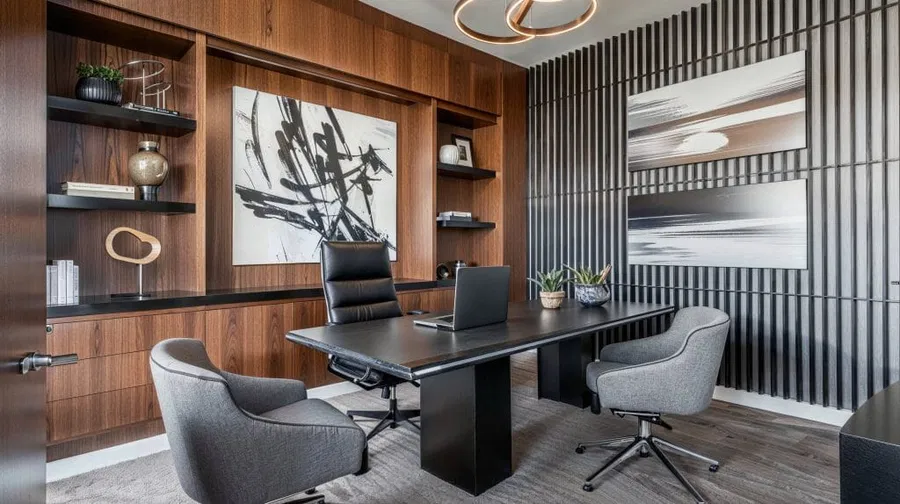Answers For VOL 5 Test 2 - Office Design
Answers and detail explain for VOL 5 Test 2 - Office Design
Explain
VOL 5 Test 2 - Office Design

Lecturer: Hello, everyone. I recently completed some important research into the way office space is designed and its impact on employees. The open plan office had been the norm for offices around the world. I'm sure you can picture one, a big room with maybe 50 or a 100 workers sitting at their workstations. You might think open plan designs are a recent phenomenon, but 1they actually came about in the early twentieth century, when businesses needed large numbers of people to do typing.
These employees, usually women, used to have to sit in rows working away at their typewriters under the watchful eye of their supervisor. Over the years, designers have come up with several variations on the open theme. In particular, this has been achieved through furnishings. 2The early designs featured separate desks. A subsequent design introduced the concept of the cubicle.
3These can have either high screens that workers can't see over or a screen just low enough to keep a lookout for the manager. And nowadays, with the increase in large call centres, a phenomenon known as hot disking is common. In this system, 4employees working on different shifts are asked to share the same workstation. As you can imagine, this is not very popular with staff as there is little opportunity to personalise your workspace. In fact, my research shows that employees in general dislike the open plan design.
As a part of my research, I conducted a survey of the staff in several large companies with open plan offices. The employees all voiced similar concerns about the design. Firstly, 5they felt that the open plan took away their privacy, But many also felt the need to carry their valuables with them at all times. So to some extent, they also felt there was less 6security with these designs. Another common complaint may be something for employers to consider when choosing this type of design and this was that these types of office space are bad for the 7health.
I was intrigued by this possibility but looking at staff records, it does seem to be borne out. So if this design is so unpopular, why is it so commonplace? Well, the answer to that is in the benefits that the employers feel this type of design has. Of course, there is the obvious benefit that this design significantly reduces costs, both in terms of rent and even in terms of 8energy use. Employers also argue that an open plan design leads to better teamwork and communication.
They also feel that new staff can learn from observing other workers, so 9this design can actually help in training staff. However, the complaints voiced by employees seem to suggest that the disadvantages far outweigh the advantages. The reality is that unhappy workers are unlikely to work well together and there is plenty of evidence to suggest 10workers are frequently distracted from their work by the noise that is all around them. What is clear is that as designers, we need to think carefully about the impact that our design has both on the staff involved and the work that they do.
Questions 1-10
Complete the form below. Write ONE WORD AND/OR A NUMBER for each answer.
Early 20th Century
-
workers employed to do 1 (typing) were arranged in rows
1960s to present
Variations in design of open-plan offices:
-
first, workers had individual 2 (desks)
-
later, they had cubicles with high or low 3 (screens)
-
nowadays, workers may have to 4 (share) a work area
Survey results
Attitudes of employees to open-plan designs:
-
there is a lack of 5 (privacy) and 6 (security)
-
they pose a risk to our 7 (health) (staff records support this)
Attitudes of employers to open-plan designs:
-
they significantly reduce rent and 8 (energy) costs
-
they improve teamwork and communication
-
they can make 9 (training) staff easier
In reality, employees are unhappy and they are often distracted by the 10 (noise) the office.
![[Forecast Q2-2025] - Biology lecture](https://static.helik.app/reading/8fd3d7d2-ccf9-47a3-8920-2e7a3b0d6607)
![[Forecast Q2-2025] - Living in the City](https://static.helik.app/reading/1a60bcf3-f3a7-4e9b-97a2-94d156a0de3b)
![[Forecast Q2-2025] - Student Union](https://static.helik.app/reading/fb443123-8c1d-447e-8c79-5a01650f4754)
![[Forecast Q2-2025] - Fruit-picking Job in an Orchard](https://static.helik.app/reading/e1968346-6c55-44ae-b8d3-f6a4fb7207b9)
![[Forecast Q2-2025] - University Crime Prevention](https://static.helik.app/reading/bdda593e-16d6-4c72-8a12-b116e917b27c)
![[Forecast Q2-2025] - Business Course](https://static.helik.app/reading/3308e282-99a6-4bcb-9d22-0b488701d968)
![[C20T1] - Choosing a restaurant](https://static.helik.app/reading/e9b21123-c43c-42fb-88b7-5d0be3a37e03)
